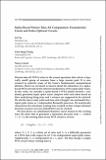Spike-Based Winner-Take-All Computation: Fundamental Limits and Order-Optimal Circuits
Author(s)
Su, Lili; Chang, Chia-Jung; Lynch, Nancy
DownloadPublished version (616.2Kb)
Publisher Policy
Publisher Policy
Article is made available in accordance with the publisher's policy and may be subject to US copyright law. Please refer to the publisher's site for terms of use.
Terms of use
Metadata
Show full item recordAbstract
© 2019 Massachusetts Institute of Technology. Winner-take-all (WTA) refers to the neural operation that selects a (typ-ically small) group of neurons from a large neuron pool. It is conjectured to underlie many of the brain’s fundamental computational abilities. However, not much is known about the robustness of a spike-based WTA network to the inherent randomness of the input spike trains. In this work, we consider a spike-based k–WTA model wherein n randomly generated input spike trains compete with each other based on their underlying firing rates and k winners are supposed to be selected. We slot the time evenly with each time slot of length 1 ms and model the n input spike trains as n independent Bernoulli processes. We analytically characterize the minimum waiting time needed so that a target minimax decision accuracy (success probability) can be reached. We first derive an information-theoretic lower bound on the waiting time. We show that to guarantee a (minimax) decision error ≤ δ (where ≤ δ (0, 1)), the waiting time of any WTA circuit is at least ((1 − δ) log(k(n − k) + 1) − 1)TR, where R c (0, 1) is a finite set of rates and TR is a difficulty parameter of a WTA task with respect to set R for independent input spike trains. Additionally, TR is independent of δ, n, and k. We then design a simple WTA circuit whose waiting time is (Formula presented) 1 O log + log k(n − k) TR, δ provided that the local memory of each output neuron is sufficiently long. It turns out that for any fixed δ, this decision time is order-optimal (i.e., it matches the above lower bound up to a multiplicative constant factor) in terms of its scaling in n, k, and TR.
Date issued
2019Department
Massachusetts Institute of Technology. Department of Brain and Cognitive Sciences; Massachusetts Institute of Technology. Computer Science and Artificial Intelligence LaboratoryJournal
Neural Computation
Publisher
MIT Press - Journals